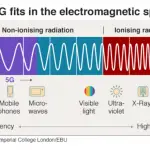Last Updated on 12 months by Francis
Vertigo is a feeling of dizziness or spinning, which can be caused by various factors such as inner ear problems, head injuries, and migraines. However, some people believe that exposure to electromagnetic fields (EMF) can also cause vertigo. In this article, we will explore the relationship between EMF and vertigo and examine the scientific evidence behind this claim.
Vertigo is a condition characterized by dizziness and a spinning sensation. There are various factors that can contribute to vertigo, including head injuries, inner ear problems, and migraines. Another potential factor that has raised concern in recent years is electromagnetic fields (EMF), which are generated by electronic devices and power lines. This topic explores whether EMF exposure can cause or worsen vertigo symptoms.
Contents
What is EMF?
Electromagnetic fields are generated by electrical devices and power lines. They are a type of radiation that consists of electric and magnetic fields that oscillate at right angles to each other. EMF is present everywhere in our environment, and we are constantly exposed to it.
Types of EMF
There are two types of EMF: ionizing and non-ionizing. Ionizing radiation has enough energy to remove an electron from an atom, which can be harmful to living organisms. Examples of ionizing radiation include X-rays and gamma rays. Non-ionizing radiation has less energy and cannot remove electrons from atoms. Examples of non-ionizing radiation include radio waves, microwaves, and infrared radiation.
There is no conclusive evidence to suggest that EMF exposure can cause vertigo. However, some people report experiencing dizziness and disorientation when they are exposed to high levels of EMF. The symptoms are similar to vertigo, but they are not the same thing.
There is no concrete evidence to suggest that exposure to EMF causes vertigo, although some people may report feeling dizzy or disoriented when exposed to high levels of EMF. Other factors, such as inner ear problems or migraines, can also cause vertigo, and it is crucial to rule out these factors before attributing symptoms to EMF exposure. EMF shielding products, such as fabric, paint, or devices, can be used to reduce exposure to EMF. It is essential to consult with a healthcare professional to determine the underlying cause of vertigo or dizziness.
Studies on EMF and Vertigo
Several studies have investigated the relationship between EMF exposure and vertigo. One study found that people who reported sensitivity to EMF were more likely to experience vertigo than those who were not sensitive. However, this study did not prove that EMF exposure caused vertigo.
Another study found that exposure to EMF from mobile phones did not cause vertigo or other neurological symptoms. The study involved more than 100 participants who were exposed to different levels of EMF from mobile phones. The researchers concluded that there was no evidence to suggest that EMF exposure caused vertigo.
Other Factors
There are many other factors that can cause vertigo, including inner ear problems, head injuries, and migraines. It is important to rule out these factors before blaming EMF exposure for your symptoms. If you are experiencing vertigo or dizziness, you should consult with a healthcare professional to determine the underlying cause.
Protecting Yourself from EMF
If you are concerned about EMF exposure, there are several steps you can take to protect yourself. These include:
- Limiting your use of electronic devices, such as mobile phones and laptops.
- Using a headset or speakerphone when making phone calls.
- Keeping your distance from electrical devices and power lines.
- Using EMF shielding products, such as shielding fabric and paint.
EMF Shielding Products
EMF shielding products are designed to reduce your exposure to EMF. They work by creating a barrier between you and the source of EMF. There are many different types of EMF shielding products, including:
- EMF shielding fabric: This fabric is made from a blend of silver and nylon fibers. It can be used to make clothing, bedding, and curtains.
- EMF shielding paint: This paint contains metal particles that reflect EMF. It can be applied to walls and ceilings to create a shielded room.
- EMF shielding devices: These devices, such as EMF meters and EMF blockers, can be used to measure and reduce your exposure to EMF.
FAQs for Can EMF Cause Vertigo
What is EMF?
EMF stands for Electromagnetic Field that is generated by electrically charged objects. Electrical appliances, power lines, and wireless devices are some of the sources of EMF.
What is vertigo?
Vertigo is a medical condition that is characterized by dizziness and a sensation of spinning or swaying.
Can EMF cause vertigo?
While there is no conclusive evidence that EMF can cause vertigo, studies have shown that exposure to high levels of EMF can lead to dizziness, nausea, headaches, and fatigue. EMF has also been linked to other health issues such as insomnia, anxiety, and depression. If you experience vertigo or any other symptoms related to EMF exposure, it is recommended to seek medical advice.
How to reduce EMF exposure?
To reduce your exposure to EMF, you can take a few measures such as using shielding materials for electronic devices, limiting the use of wireless devices, and keeping a distance from the sources of EMF like power lines and transformers. It is also suggested to turn off the electrical appliances when not in use.
Can EMF exposure have long-term effects?
Studies are still being conducted to determine the long-term effects of EMF exposure. Some researchers suggest that prolonged exposure to high levels of EMF can increase the risk of developing certain cancers, neurological disorders, and cardiovascular diseases. However, more evidence is needed to confirm these claims. It is recommended to take preventive measures to reduce your EMF exposure.







